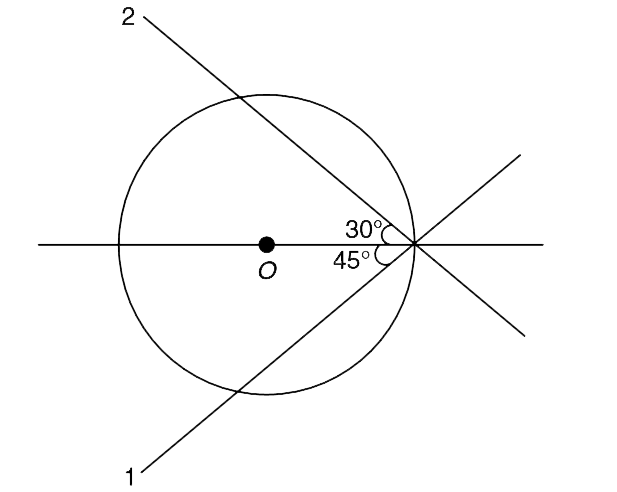A circular disc fixed at its centre to a metal wire and the other end of the wire is clamped. The disc is rotated about the wire as axis and is released. The disc about this axis makes simple harmonic oscillations with a frequency of 12Hz. If moment of inertia of the disc about this axis is 0.1 kg −m2, the torsional constant of the wire is
0.99 kg m2s−2
0.45 kg m2s−2
09.9 kg m2s−2
0.49 kg m2s−2
The correct Answer is:A
To find the torsional constant K of the wire in the given problem, we can use the relationship between the frequency of oscillation, moment of inertia, and the torsional constant. Here’s a step-by-step solution:
Step 1: Understand the relationship between frequency, moment of inertia, and torsional constant
The frequency f of a torsional oscillator is given by the formula:
f=12π√KI
where:
- K is the torsional constant,
- I is the moment of inertia.
Step 2: Rearrange the formula to solve for K
We can rearrange the formula to express K in terms of f and I:
K=(2πf)2I
Step 3: Substitute the given values
From the problem, we know:
- The frequency f=12 Hz,
- The moment of inertia I=0.1 kg·m².
Now substitute these values into the equation:
K=(2π⋅12)2⋅0.1
Step 4: Calculate K
First, calculate 2π⋅12:
2π⋅12=π
Now square it:
(π)2≈3.142≈9.8596
Now multiply by 0.1:
K=9.8596⋅0.1≈0.98596 kg⋅m2/s2
Step 5: Round the answer
Rounding this value gives:
K≈0.99 kg⋅m2/s2
Final Answer
The torsional constant K of the wire is approximately 0.99 kg⋅m2/s2.
---
The frequency f of a torsional oscillator is given by the formula:
f=12π√KI
where:
- K is the torsional constant,
- I is the moment of inertia.
We can rearrange the formula to express K in terms of f and I:
K=(2πf)2I
From the problem, we know:
- The frequency f=12 Hz,
- The moment of inertia I=0.1 kg·m².
K=(2π⋅12)2⋅0.1
First, calculate 2π⋅12:
2π⋅12=π
Now square it:
(π)2≈3.142≈9.8596
Now multiply by 0.1:
K=9.8596⋅0.1≈0.98596 kg⋅m2/s2
Rounding this value gives:
K≈0.99 kg⋅m2/s2
The torsional constant K of the wire is approximately 0.99 kg⋅m2/s2.
Topper's Solved these Questions
Similar Questions
(a) A uniform disc of radius 5⋅0cm and mass 200g is fixed at its centre to a metal wire, the other end of which is fixed with a clamp. The hanging disc is rotated about the wire through an angle and is released. If the disc makes torsional oscillations with time period 0.20s, find the torsional constant of the wire.
(b) In the previous part, another disc is placed over the first one and the time period of the system become 0.65. Find the M.I. of the second disc about the wire.
View SolutionA uniform disc of radius 5.0 cm and mass 200g is fixed at its centre to a metal wire, the other end of which is fixed with a clamp. The hanging disc is rotated about the wire through an angle and is released. If the disc makes torsional oscillations with time period 0.20s, find the torsional constant of the wire.
View Solution
Knowledge Check
Moment of inertia of a disc about its own axis is I. Its moment of inertia about a tangential axis in its plane is
A52IB3IC32ID2IA brass disc is rotating about its axis. If temperature of disc is increased then its
Aradius of gyration increases, but moment of inertia remains the sameBmoment of inertia increases but radius of gyration remains the sameCradius of gyration, moment of inertia both remain the sameDradius of gyration, moment of inertia both increaseIf the radius of gyration of a solid disc of mass 10 kg about an axis is 0.40 m, then the moment of inertia of the disc about that axis is
A1.6kg m2B3.2kg m2C6.4kg m2D9.5kg m2
Moment of inertia of a disc about its own axis is I. Its moment of inertia about a tangential axis in its plane is
View SolutionA circular disc of mass 12 kg is suspended by a wire attached to its centre. The wire is twisted by rotating the disc and then released, so that the time period of torsional oscillation is 2 s. If the radius of the disc is 10 cm, then calculate the torsional spring constant of the wire.
View SolutionCalculate the ratio of moment of inertia of a thin uniform disc about axis 1 and 2 marked in the figure. O is the centre of the disc.

View SolutionA disc of radius 10 cm can rotate about an axis passing through its centre and perpendicular to its plane. A force of 10 N is applied along the tangent in the plane of the disc. If the moment of inertia of the disc about its centre is 5kgm2, then the increase in the angular velocity of the disc in 10 s will be
View SolutionThe moment of inertia of a circular disc about an axis passing through its centre and perpendicular to the plane is 4kgm2 . Its moment of inertia about the diameter is
View Solution
